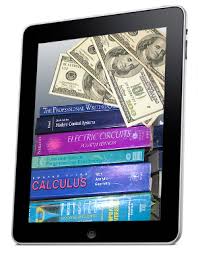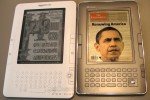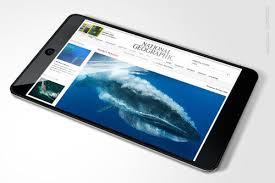(Brought over from
A Kindle World -
Originally there March 10, 2010)
It seems the market will be flooded with tablets or slates competing with the iPad.
UPDATE 3/13/10 - Seven alternatives to the Apple iPad - Mainly large photos and specs, pro and con, at linked CrunchGear site.
HP Slate
For those reading this on a computer, the HP Slate now has a
5-1/2 minute youtube video demo'g its flash support and Adobe Air (missing from the iPad) and it's very impressive. Start it at minute 1:18 as he just talks for too long when introducing it.
ADAM by Notion Ink

Goodereader reports on
the Adam from Notion Ink, the first gizmo that will be released with the Pixel QI screen, that can alternate between an e-paper type display and an LCD one and doesn't depend only on its own power source for the screen's light.
Unlike the iPad, Goodereader says, its backlight can be turned on or off, reducing battery drain by 50% and allowing 16 hours of Internet usage while the iPad's is expected to be about 10 hours (the latest release info from Apple says the number of hours is subject to many conditions).
With a 10" screen, it uses the Android system, has HDMI output, 3 USB ports, can multitask, has GPS, a digital compass, a 3 megapixel camera, and is memory-card expandable to 32 gig. It weighs a bit over 1-1/2 lbs. Here's an
article that includes an e-mail interview with the CEO (from India) and a chart of Adam features vs the iPad.
Smartmoney.com quotes a consultant who says the Adam "is probably closer to what the second-generation iPad will be than what the iPad currently is."
John Dvorak asks, "
iPad killer from, uh, India?" and still wonders if there's a market for a tablet computer. Seems so! though not at some of the pricing we've seen when you want 3G cellular wireless capability and while being asked to forego multitasking capability, usb ports, webcam, flash support for the Web etc.
And here's
iSlate headlining, "
Notion Ink's Adam Considered to be a big contender against the iPad." It's a detailed article if you want to read more on this.
The most attractive part from all that? Starting price will be about
$325
.
DELL MINI 5 or "Streak"

Dell is apparently creating a small one that will be
able to read Kindle books ! The screen size is smaller than the
Kindle though but considerably larger than most smartphones and would be an "always-On" web device, running Android 2, with a 3G phone, WiFi, GPS, a 5-megapixel camera and a forward-facing camera for video calls, 1.6G internal storage (before system files) and a micro SD card slot.
Engadget received a flyer with confirmed specs and colorful models. Their
earlier article on Feb. 26 reported the Dell Mini wouldn't be out for at least another month and referenced
Wired's quote from Neeraj Choubey, GM of Dell's tablet division, that there'll be " '
a family of tablets' which will 'scale up to a
variety of sizes' and that it'll likely be Android all the way, while Choubey also shared his company's intention to bundle '
inexpensive data plans' with the new devices...'
Choubey confirmed to
Laptop that Dell is working with AT&T (yikes, are they the carrier for most of the e-readers and tablets?). The leaked internal document they got states:
' The second page details a content partnership that Dell may be entering with Amazon. The document states that the Mini 5 will integrate with Amazon's Kindle, MP3 and Video services, and will include a Kindle reader app. '
It also refers to the Snapdragon-powered device as the 'Streak.' No solid release date or final price yet.
Hmmm,
Infomobile has a
huge picture of a proposed Dell ad about the Amazon deal and, in an earlier story,
a brief video of the little unit, plus a description of the
not-gonna-fly price - unsubsidized (no data plan: $1098 and maybe $600-$700 with plan). It does have a phone. See update below: Wired's writer feels Dell would tend to undercut Apple's pricing.
UPDATE - 11:35 AM, same day.
Wired's Eliot Van Buskirk adds that
' The documents also indicate that — like Kindle owners — users of this Dell mini-tablet will have wireless (3G) access to the Kindle store with “no monthly fees, service plans, or hunting for a Wi-Fi spot.” If that’s the case, Dell’s tablets would have a significant advantage over the iPad, which can only access the 3G network if you pay for the more expensive version of the hardware and sign up for a $15 or $30 per month data plan in addition to whatever wireless data plan you have for your phone. '
IPAD VIDEO AD

And with all tablets, there's one unusual inherent problem for users: here's Apple's first
iPad video ad. Liliputing makes sport of the new, very effective iPad ad in that they draw attention to the odd positions of everyone using the iPad in that ad - their legs are in unusual positions because it needs to be propped up. I guess there'll be holders for it.


 story on the Eken M003
story on the Eken M003

 Here are the story links.
Here are the story links.  CrunchGear
CrunchGear

 Video of Len Edgerly's take on the Alex
Video of Len Edgerly's take on the Alex

 CNet's Chris Matyszczyk reports that, rejecting a settlement for $6,600,
CNet's Chris Matyszczyk reports that, rejecting a settlement for $6,600,  Consumer Reports writes
Consumer Reports writes Earlier, at the
Earlier, at the  Tech Crunch's Michael Arrington reports
Tech Crunch's Michael Arrington reports
 iPad challengers are gathering outside the castle. Besides the Dell Streak and the Adam by Notion Ink, both
iPad challengers are gathering outside the castle. Besides the Dell Streak and the Adam by Notion Ink, both  And there's a very low-cost one gaining considerable interest - the
And there's a very low-cost one gaining considerable interest - the  Goodereader reports on
Goodereader reports on  Dell is apparently creating a small one that will be able to read Kindle books ! The screen size is smaller than the
Dell is apparently creating a small one that will be able to read Kindle books ! The screen size is smaller than the  And with all tablets, there's one unusual inherent problem for users: here's Apple's first
And with all tablets, there's one unusual inherent problem for users: here's Apple's first